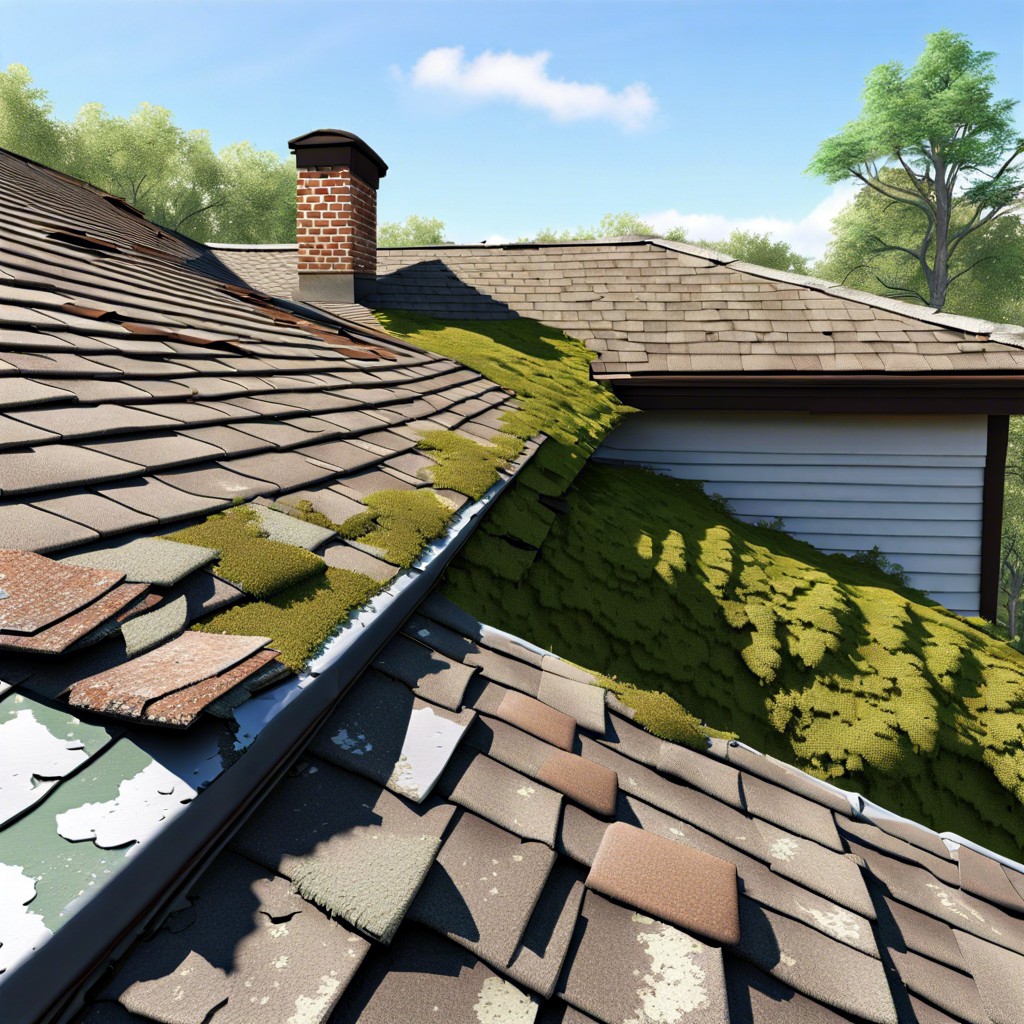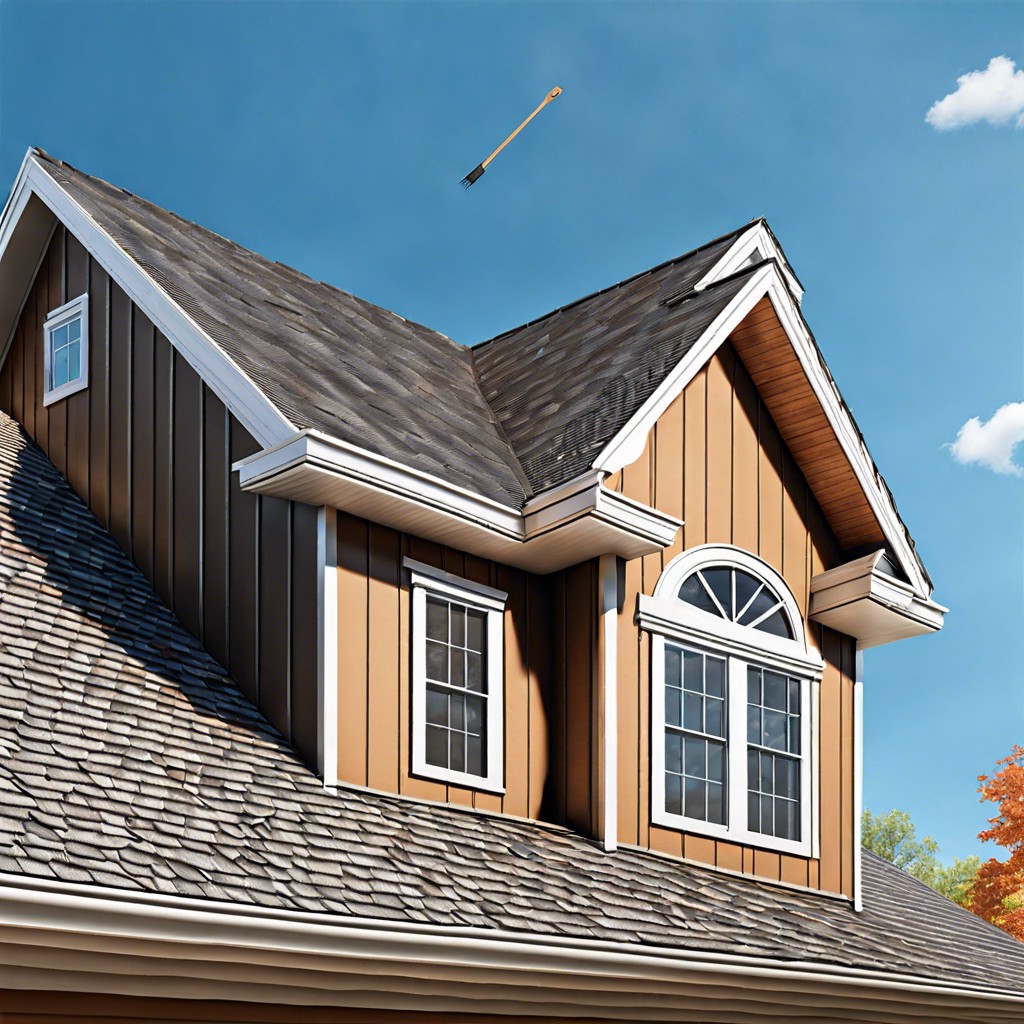Last updated on
In this in-depth guide, you’ll discover the crucial factors that determine when it’s time to replace your roof.
Key takeaways:
- Signs: curled/buckling shingles, missing shingles, granules in gutters, sunlight through roof boards, sagging roof deck
- Factors: material durability, climate, roof color, roof slope, installation quality
- Importance of regular inspections and maintenance
- Steps to address roof age and wear
- Choosing the right roofing material
Signs That Indicate the Need for a Roof Replacement

Curled or Buckling Shingles: Over time, exposure to the elements can cause shingles to curl or buckle, signaling that the roof’s protective layer is compromised and may no longer effectively repel water.
Missing Shingles: High winds and severe weather can dislodge shingles. Spots devoid of shingles leave the roof vulnerable to water infiltration and further damage.
Granules in the Gutters: As shingles begin to break down, they shed granules, which often end up in the gutters. If you start noticing an excessive amount, it could indicate that your shingles are nearing the end of their functional life.
Sunlight Through the Roof Boards: If light is visible from your attic, this is a clear sign that your roof has holes or cracks which can lead to leaks and structural damage.
Sagging Roof Deck: A sagging deck suggests that the underlying decking or supports have been weakened by moisture and rot, requiring immediate attention to prevent possible collapse.
Age of Roof: If your roof is over 20 years old, it’s wise to consider replacement, as this is the typical lifespan for many roofing materials.
Water Damage or Leaks: Regular inspections may reveal water damage or leaks, which could necessitate either repair or replacement depending on severity.
Presence of Moss and Algae: While sometimes just a cosmetic issue, excessive growth can trap moisture and compromise the roof structure.
These indicators, singularly or combined, suggest it’s time to consult a roofing professional to assess whether repair or full replacement is necessary.
Factors That Affect the Lifespan of a Roof
Several variables influence how long a roof can reliably protect a home:
1. Material Durability: Asphalt shingles, for instance, typically last 15-30 years, while metal roofs can endure 40-70 years, and slate, clay, or concrete roofs may last over 100 years.
2. Climate: Areas with extreme weather, such as heavy snow, hail, high winds, and temperature fluctuations, can accelerate roof deterioration.
3. Roof Color: Light-colored roofs tend to reflect sunlight and heat, potentially extending a roof’s lifespan compared to dark-colored roofs that absorb heat.
4. Roof Slope: Steeper slopes tend to shed water and debris more effectively than low-slope roofs, potentially reducing the risk of water damage and extending the roof’s life.
5. Installation Quality: Proper installation by professional roofers ensures a roof is set up for maximum longevity; poorly installed roofs may fail prematurely.
6. Ventilation: Adequate attic ventilation keeps the roof system cool and dry, preventing damage from heat and moisture buildup.
7. Maintenance History: Regular inspections and prompt repairs can catch and fix small issues before they lead to larger, more costly problems.
8. Surrounding Environment: Trees close to a home can scratch or puncture roofing materials; proximity to the ocean can expose a roof to salt spray, contributing to corrosion.
Understanding these factors can help homeowners anticipate maintenance needs and make informed decisions about roof replacements when the time comes.
Importance of Regular Roof Inspections and Roof Maintenance
Regular inspections and maintenance play a crucial role in extending the life of your roof and identifying potential issues before they require full replacement. To ensure your roof remains in top condition, consider the following:
1. Biannual Checks: Aim to inspect your roof at least twice a year, typically in the spring and fall, to assess any damage from seasonal weather changes.
2. Professional Examination: While personal checks are valuable, a professional roofer can identify subtleties that may be missed by the untrained eye, ensuring a thorough assessment.
3. Debris Removal: Keep the roof clear of debris such as leaves, twigs, and dirt, which can retain moisture and cause rot or mold growth.
4. Gutter Maintenance: Clean gutters and downspouts regularly to prevent water from backing up under roofing materials, which can lead to water damage and weaken the roof structure.
5. Trim Overhanging Branches: Cut back any branches that hang over your roof to reduce the risk of damage from falling limbs and to decrease the accumulation of leaf litter.
6. Immediate Repairs: Address small issues, like missing shingles or minor leaks, promptly to prevent them from escalating into bigger, more costly problems.
7. Ventilation and Insulation Monitoring: Ensure proper attic insulation and ventilation. Poor insulation and inadequate ventilation can cause heat and moisture buildup that may decrease the roof’s longevity.
Steps for Addressing Roof Age and Wear
To effectively manage roof age and wear, begin with a professional assessment to determine the current state. This evaluation should cover potential leaks, damaged or missing shingles, and structural integrity. If the roof’s age is approaching the standard lifespan—a figure that varies depending on materials used—it’s prudent to budget for replacement.
In the interim, preventative maintenance can extend the life of your roof. This includes the clearing of debris, ensuring gutters are clean to prevent water buildup, and replacing damaged shingles promptly to avoid further deterioration. It’s also important to check for and seal any potential entry points for water to prevent internal home damage.
For roofs in coastal or severe weather-prone areas, additional measures may be necessary. This can include more frequent inspections and specialized materials to withstand environmental stresses.
Stay vigilant about tree overhangs; branches can scratch roofing materials and drop debris that causes wear. Trim these back to reduce wear and avoid accumulation of organic material that encourages moss and mold growth.
By meticulously managing these aspects, homeowners can mitigate the effects of aging and weathering, thereby extending their roof’s serviceable life before a complete replacement becomes essential.
Choosing the Right Roofing Material
Selecting appropriate roofing materials is pivotal for maximizing longevity and ensuring cost-effectiveness. Here are key considerations:
- Climate Compatibility: Choose materials that withstand local weather conditions. For instance, metal excels in snow-prone areas, while clay tiles are ideal in hotter climates.
- Durability: Assess the lifespan of different options. Slate roofs can last over a century, whereas asphalt shingles typically offer around 20 years of service.
- Energy Efficiency: Reflective or “cool” roofing options can reduce cooling costs by reflecting sunlight away from the home.
- Aesthetic and Architectural Suitability: The material should complement your home’s architectural style, whether it’s traditional, modern, or historic.
- Environmental Impact: Consider eco-friendly materials like recycled shingles or metal that offer sustainability benefits.
- Weight: Ensure your home’s structure can support heavier materials like slate or tile without additional reinforcement.
- Maintenance Requirements: Factor in the upkeep needed to maintain the roof’s integrity and appearance over time.
- Cost: Budget for both the initial installation and the long-term expenses associated with the chosen material’s maintenance and potential for repairs.
By weighing these factors, homeowners can select a roofing material that best serves their specific needs and preferences.
FAQ
How do you know it’s time to replace your roof?
It’s time to replace your roof when you notice signs such as drooping or sagging, trapped moisture, rotting boards, or sagging spots, especially at the lowest points.
What is the typical life expectancy of a roof?
The typical life expectancy of a roof generally spans from 25 to 50 years, contingent upon the quality, durability, and kind of material used.
How many times can a roof be Reshingled?
A roof can be reshingled up to two times, according to most building codes that generally allow for up to two layers of organic or fiberglass asphalt shingles, particularly for roofs with a 4:12 pitch.
Is it OK to shingle over an existing roof?
Yes, it is possible to lay new roof shingles over the old ones, although there are benefits and drawbacks that should be considered.
What are the key signs of a deteriorating roof that requires replacement?
Key signs of a deteriorating roof demanding replacement include recurring leaks, missing or damaged shingles, sagging, moss or mold growth, rotten wood, cracked flashing, decrepit roof valleys, granules in gutters, and increasing energy bills.
Can extreme weather conditions shorten the lifespan of a roof?
Yes, extreme weather conditions can significantly shorten the lifespan of a roof.
How does the choice of roofing materials impact the frequency of roof replacement?
The choice of roofing materials significantly influences the frequency of roof replacement, as durable materials like metal or slate increase the lifespan of the roof, reducing the need for regular replacements.




